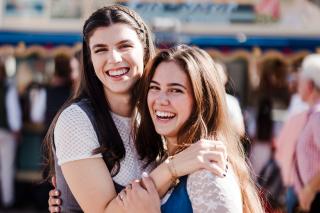The long history of a special traditional costume
The dirndl has undergone an amazing transformation in its history. Today there are dirndls in all variations. The traditional models, which are common everywhere in Bavaria, the mini dirndls in neon colors, which are mainly reserved for tourists and even exclusive haute couture dirndls, where there is no upper limit in terms of price. In the past, however, dirndls were pure work clothes and had to be one thing above all: practical.

Why every woman looks good in dirndl
The Dirndl is not a dress like any other. It stands for the love of tradition, for customs and a very special attitude to life. And: every woman looks good in it. So it's no wonder that the dirndl is so popular. In the past, however, the traditional dress was not worn for its visual advantages, but for other reasons.
The history of the dirndl: today a festive garment, in former times a work outfit
The term Dirndl is derived from the term "Diernen". This was the name given in the 19th century to the maids who worked on farms in Bavaria and Austria. Their typical working garb looked like this: Over the shirt was the "Leiblgwand". This we know today as the Dirndl dress. An apron was worn over the dress, which had little to do with the noble models of today. Instead of velvet and silk, bed linen was used to make the aprons in those days. If one was lucky, the pattern was not completely tasteless. Floral and vine patterns sometimes appeared naturally, but most Dirndl aprons were plain and monochromatic. "A dress to subjugate them" - in those days it was indeed so. Unlike today, the Dirndl was not worn to the Oktoberfest or the folk festival, but to clean, work in the stables and in the fields.
Suddenly trend - the Dirndl comes out big
Around 1930, the dirndl experienced a real hype. City women traveling to the mountains for recreation took a liking to the "look" of the maids - pimped out in keeping with their status, of course. The kitsch operetta "Im weißen Rössl" with Theo Lingen contributed to the new popularity of the dirndl. The dirndl trend also caused a sensation in the U.S., where "The White Horse" was a box-office hit on Broadway in New York and was performed 223 times. Suddenly, traditional costume was chic, and those who wanted to be at the forefront of fashion wore dresses with traditional costume elements. For the summer version of the dirndl, puffed sleeves, laced bodices and aprons were adopted. For the winter version, warming flannel fabrics in the colors loden green and dark blue were used.
Each Dirndl region has its own speciality
Then as now, Dirndl is not just Dirndl. From region to region, from place to place, various special features have been added over the years that make the individual traditional costume look unique and unmistakable. In Passau in Lower Bavaria, for example, the traditional costume includes a gold hood. Although not far from Passau, the tranquil town of Hinterskirchen, on the other hand, attaches great importance to other details. For example, the ladies there not only wear blue knee socks, but also a crown (Kranl) - but the latter only when they are not yet under the hood (married). Tradition-conscious Dirndl wearers in Upper Bavaria, on the other hand, usually opt for the choker as an accessory. In the end, the individual Trachten look is always a mixture of customs and personal taste.


